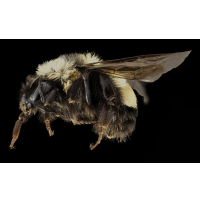Government Urges That Bumble Bee Be Placed on Endangered Species List
 Rusty patched bumble bee--Credit: USGS Bee Inventory and Monitoring Lab
Rusty patched bumble bee--Credit: USGS Bee Inventory and Monitoring Lab
By Gillian Flaccus, Associated Press
PORTLAND, Ore. — Federal wildlife officials on Thursday made a formal recommendation to list the rusty patched bumble bee as an endangered species because it has disappeared from about 90% of its historic range in just the past two decades.
The U.S. Fish and Wildlife Service made the recommendation after the Portland, Oregon-based Xerces Society petitioned the agency on behalf of the bee in 2013 and presented studies showing it was struggling due to a combination of disease, habitat loss, climate change and overuse of pesticides on commercial crops.
If approved, the species would be the first bee listed as endangered in the continental United States, said Rich Hatfield, senior conservation biologist with the Xerces Society.
The group, which advocates for the preservation of pollinator insects such as butterflies and bees, used “citizen scientists” to take counts of the rusty patched bumble bees.
The bees once ranged over 28 states stretching from Minnesota to Maine and into parts of Canada, but are now limited to small and scattered colonies in about a dozen states, including Illinois, Ohio and Minnesota, and one Canadian province, the Fish and Wildlife Service said in a statement Thursday.
Even those populations may have disappeared or been reduced because the last counts were done in 2000, the agency said.
“This is a very difficult thing to track. It’s not like honey bees that are out in boxes that people can go out and count so keeping track of them in the wild is very difficult,” Hatfield said of the bumble bee’s numbers.
The rusty patched bumble bee gets its name for a crescent-shaped, reddish patch on its abdomen. It is one of 4,000 native bee species in North America, Hatfield said.
It is an important pollinator for crops such as cranberries, blueberries and tomatoes and has increasingly been used in commercial farming because it is bigger and stronger than the honey bee. Because of its bigger size, it causes a higher vibration in the pollen-laden anthers of the flowers it is visiting, resulting in more and better fruit harvests, Hatfield said.
But the populations of bumble bees being used to pollinate greenhouse tomatoes, cranberry bogs and blueberry fields have become infected by disease and spread a virulent pathogen to their wild cohorts, causing those colonies to collapse, he said. The phenomenon is similar to the colony collapse that has affected honey bees in recent years, he said.
Honey bees create hives of up to 50,000 individuals and make honey to survive through the winter. Bumble bees live in small colonies of 50 to 500 individuals and don’t make honey because they don’t live through the winter, Hatfield said.
They rarely sting because they don’t have large colonies to protect and don’t have a honey stash to defend, he added.
Seven species of yellow faced bee in Hawaii were proposed for listing by the Fish and Wildlife Service last year, but the recommendation has yet to be finalized, Hatfield said.
“I think one of the great things about pollinator conservation in general is that no matter where you live, you can do something about this,” Hatfield said. “All these animals need our flowers from spring through fall and if we can help create or restore some habitat that’s been lost, we can give bees a chance to recover.”
The public has 60 days to comment on the proposed listing for the rusty patched bumble bee and the agency will make a final ruling within a year of Thursday’s date, said Georgia Parham, an agency spokeswoman.
To Learn More:
Organized Crime Muscles into New Field: Endangered Species (by Noel Brinkerhoff, AllGov)
U.S. Wildlife Service Accused of Caving to Timber Industry Pressure in Denying Protection for Endangered Bats (by Ramona Young-Grindle, Courthouse News Service)
Obama-Appointed Judge Accuses Fish and Wildlife Service of Failing to Protect Endangered Wolverine (by Matthew Brown, Associated Press)
- Top Stories
- Unusual News
- Where is the Money Going?
- Controversies
- U.S. and the World
- Appointments and Resignations
- Latest News
- Musk and Trump Fire Members of Congress
- Trump Calls for Violent Street Demonstrations Against Himself
- Trump Changes Name of Republican Party
- The 2024 Election By the Numbers
- Bashar al-Assad—The Fall of a Rabid AntiSemite






Comments